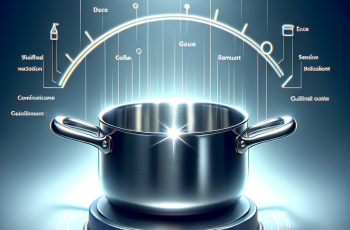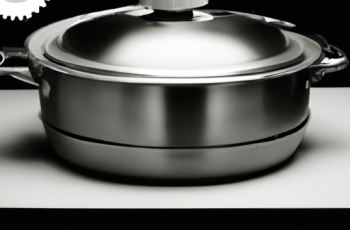Ad Blocker Detected
Our website is made possible by displaying online advertisements to our visitors. Please consider supporting us by disabling your ad blocker.
In this article, we will explore the advantages and disadvantages of using copper-bottomed saucepans. Copper-bottomed saucepans have long been a staple in professional kitchens due to their excellent heat distribution and quick response time. However, they also come with a few drawbacks that need to be considered. By examining both the pros and cons, you can make an informed decision on whether copper-bottomed saucepans are the right choice for your kitchen.

Pros of Copper-Bottomed Saucepans
Excellent Heat Conductivity
One of the major advantages of using copper-bottomed saucepans is their excellent heat conductivity. Copper is known for its superior ability to conduct heat efficiently and evenly across the entire surface. This means that your food will heat up quickly and evenly, reducing the risk of hot spots or uneven cooking. This is especially beneficial when it comes to delicate dishes that require precise temperature control.
Precise Temperature Control
Copper-bottomed saucepans offer excellent temperature control due to their efficient heat conductivity. Copper reacts quickly to changes in heat, allowing you to adjust the temperature with precision and accuracy. This is particularly important when you’re working with recipes that require specific temperature ranges, such as delicate sauces or candies. With copper-bottomed saucepans, you can have more control over your cooking process and achieve better culinary results.
Quick Heating and Cooling
Thanks to its exceptional heat conductivity, copper-bottomed saucepans heat up rapidly, reducing the waiting time before you can start cooking. This is particularly advantageous when you’re in a hurry or when you’re working with time-sensitive recipes. Additionally, copper has the ability to cool down quickly once removed from the heat source, helping you prevent overcooking or burning your food. This feature makes copper-bottomed saucepans a valuable asset in any kitchen.
Uniform Heat Distribution
When cooking with copper-bottomed saucepans, you can expect a uniform distribution of heat throughout the cooking surface. This is due to copper’s efficient heat conductivity, which ensures that all parts of the pan reach the same temperature. As a result, you can achieve consistent cooking results, minimizing the risk of undercooking or overcooking certain areas of your food. With copper-bottomed saucepans, you can have the confidence that your dishes will be cooked evenly from edge to edge.
Attractive and Aesthetic
Apart from their practical benefits, copper-bottomed saucepans also add a touch of elegance and sophistication to your kitchen. The shiny, metallic appearance of copper is visually appealing and can enhance the overall aesthetic of your cooking space. Whether you have a modern or traditional kitchen design, copper-bottomed saucepans can effortlessly blend in and elevate the visual appeal of your culinary environment.
Durable and Long-Lasting
Copper-bottomed saucepans are known for their durability and longevity. Copper is a sturdy and robust material that can withstand the test of time, making it an excellent investment for your kitchen. With proper care and maintenance, copper-bottomed saucepans can last for generations, ensuring that you can enjoy their benefits for years to come. Their durability also makes them less prone to warping or denting, further adding to their value and reliability.
Versatile for Different Cooking Techniques
Copper-bottomed saucepans are highly versatile and can be used for a wide range of cooking techniques. Whether you’re simmering, sautéing, braising, or boiling, copper-bottomed saucepans can handle it all. The even heat distribution and precise temperature control provided by copper make it an ideal choice for various cooking methods. From delicate sauces to hearty stews, these saucepans can accommodate different culinary endeavors with ease.
Ideal for Specific Foods
Certain types of dishes benefit greatly from the use of copper-bottomed saucepans. Copper is particularly well-suited for cooking foods that require precise temperature control, such as sugar-based candies or delicate custards. The efficient heat conductivity of copper ensures that these foods heat up quickly and evenly, preventing unwanted scorching or curdling. If you frequently prepare recipes that demand careful temperature management, copper-bottomed saucepans can be an invaluable tool in your kitchen arsenal.
Healthy Cooking Option
Copper-bottomed saucepans offer a healthy cooking option due to their excellent heat conductivity. This allows you to cook at lower temperatures, reducing the risk of overheating or burning your food. Lower cooking temperatures can help retain the nutritional value of your ingredients and preserve their natural flavors and textures. Additionally, copper has natural antimicrobial properties that can help inhibit the growth of bacteria, making it a hygienic choice for your cooking needs.
Easy Maintenance
Contrary to popular belief, copper-bottomed saucepans are relatively easy to maintain. While they may require regular polishing to maintain their lustrous appearance, cleaning them is a straightforward task. A gentle wash with warm soapy water after each use, followed by thorough drying, is usually sufficient to keep them in good condition. It is important to avoid using abrasive cleaners or scrubbers that can potentially scratch the surface. With proper care and maintenance, copper-bottomed saucepans can maintain their functionality and beauty for many years.
Cons of Copper-Bottomed Saucepans
High Price Point
One of the downsides of copper-bottomed saucepans is their relatively high price compared to other types of cookware. Copper is a premium material that comes at a cost, making it a more significant investment for your kitchen. However, it is essential to consider the long-term benefits and durability that copper-bottomed saucepans offer, which can outweigh the initial expense.
Reactivity with Certain Foods
While copper is an excellent conductor of heat, it can react with certain foods that are acidic or alkaline in nature. This chemical reaction between copper and certain ingredients can result in a metallic taste in your food. To mitigate this, copper-bottomed saucepans are often lined with a layer of stainless steel or tin, creating a barrier between the copper and your food. However, over time, these protective linings may wear off, necessitating re-lining by a professional.
Not Compatible with Induction Cooktops
Copper-bottomed saucepans are not suitable for induction cooktops, as copper is not magnetic. Induction stovetops require a magnetic material to generate heat, and unfortunately, copper does not possess the necessary properties. If you rely heavily on induction cooking, you may need to consider alternative cookware options that are compatible with this type of stovetop.
Requires Regular Polishing and Maintenance
To maintain the beautiful appearance of copper-bottomed saucepans, regular polishing is necessary. Copper naturally oxidizes over time, developing a patina that can tarnish its shine. However, with frequent polishing using copper-specific cleaning products or natural remedies like lemon and salt, you can restore its luster and keep it looking pristine. It is important to note that neglecting regular polishing can result in a dull and unappealing appearance of your copper-bottomed saucepans.
Prone to Scratches and Dents
Copper-bottomed saucepans are relatively softer compared to other materials like stainless steel or cast iron. This makes them more susceptible to scratches and dents, especially when using metal utensils or rough cleaning techniques. Careful handling and the use of non-abrasive utensils are essential to protect the surface of your copper-bottomed saucepans and maintain their integrity.
Turns Dark over Time
As copper oxidizes, its color gradually changes from the initial bright and shiny appearance to a darker, more patinated look. While this patina can add a rustic charm to your copper-bottomed saucepans, some people prefer to maintain the bright copper hue. Regular polishing and cleaning can slow down the oxidation process, but the patina will eventually develop over time.
Potential Health Risks
Although copper is generally safe to use in cookware, excessive ingestion of copper can lead to health issues. Consuming large amounts of copper can cause nausea, vomiting, and stomach cramps. To prevent any potential health risks, ensure that your copper-bottomed saucepans are lined with a protective layer of stainless steel or tin. This lining acts as a barrier and prevents direct contact between your food and the copper surface.
Limited Availability
Copper-bottomed saucepans may not be as readily available as other types of cookware. While they can be found in specialty kitchen stores or online, the selection may be more limited compared to more common materials. However, with the rise in popularity of copper cookware, the availability of copper-bottomed saucepans has improved in recent years.
Careful Handling Required
Due to their reactive nature and susceptibility to scratches and dents, copper-bottomed saucepans require careful handling. Avoid using metal utensils that can damage the surface and opt for non-abrasive materials instead. Additionally, be cautious when storing your copper-bottomed saucepans to prevent any accidental scratches or damage from other cookware items.
Lack of Non-Stick Properties
Unlike some non-stick cookware options, copper-bottomed saucepans do not possess inherent non-stick properties. This means that you may need to use additional fats or oils to prevent your food from sticking to the surface. While this may not be a significant concern for many cooks, those seeking a more oil-free or low-fat cooking experience may find this aspect of copper-bottomed saucepans less ideal.


